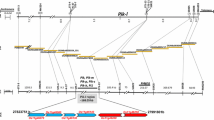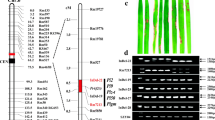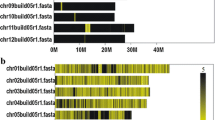Summary
Both Pi-2(t) and Pi-4(t) genes of rice confer complete resistance to the blast fungal pathogen Pyricularia oryzae Cav. As economically important plant genes, they have been recently characterized phenotypically, yet nothing is known about their classical linkage associations and gene products. We report here the isolation of DNA markers closely linked to these blast resistance genes in rice. The DNA markers were identified by testing 142 mapped rice genomic clones as hybridization probes against Southern blots, consisting of DNA from pairs of nearly isogenic lines (NILs) with or without the target genes. Chromosomal segments introgressed from donor genomes were distinguished by restriction fragment length polymorphisms (RFLPs) between the NILs. Linkage associations of the clones with Pi-2(t) and Pi4(t) were verified using F3 segregating populations of known blast reaction. Cosegregation of the resistant genotype and donor-derived allele indicated the presence of linkage between the DNA marker and a blast resistance gene. RFLP analysis showed that Pi-2(t) is closely linked to a single-copy DNA clone RG64 on chromosome 6, with a distance of 2.8+1.4(SE) cMorgans. Another blast resistance gene, Pi-4(t), is 15.3+4.2(SE) cMorgans away from a DNA clone RG869 on chromosome 12. These chromosomal regions can now be examined with additional markers to define the precise locations of Pi-2(t) and Pi-4(t). Tightly linked DNA markers may facilitate early selection for blast resistance genes in breeding programs. These markers may also be useful to map new genes for resistance to blast isolates. They may ultimately lead to the cloning of those genes via chromosome walking. The gene tagging approach demonstrated in this paper may apply to other genes of interest for both monogenic and polygenic traits.
Similar content being viewed by others
References
Bonman JM, Vergel de Dios TI, Khin MM (1986) Physiologic specialization of Pyricularia oryzae in The Philippines. Plant Dis 70:767–769
Hanson WD (1959) Early generation analysis of lengths of heterozygous chromosome segments around a locus held heterzygous with backcrossing or selfing. Genetics 44:833–837
Kinoshita T (1986) Standardization of gene symbols and linkage maps in rice. In: Rice genetics. Proc Int Rice Genet Symp, May 1985. IRRI, Los Banos, The Philippines, pp 215–228
Kiyosawa S (1981) Gene analysis for blast resistance. Oryza 18:196–203
Mackill DJ, Bonman JM, Suh HS, Srilinggam R (1985) Genes for resistance to Philippine isolates of the rice blast pathogen. Rice Genet Newslett 2:80–81
Mackill DJ, Bonman JM, Tenorio PD, Vergel de Dios TI (1988) Near-isogenic indica rice lines with blast resistance genes. Rice Genet Neslett 5:98–101
McCouch SR, Kockert G, Yu ZH, Wang ZY, Khush GS, Coffman WR, Tanksley SD (1988) Molecular mapping of rice chromosomes. Theor Appl Genet 76:815–829
Rosero MN (1967) Inheritance of resistance in rice to four international races of P. oryzae Cav. PhD thesis, Louisiana State University, Ann Arbor, MI (Diss Abstr Int 28:24-B to 25-B)
Tanksley SD, Young ND, Paterson AH, Bonierbale MW (1989) RFLP mapping in plant breeding —new tools for an old science. Biotechnology 7:257–264
Valent B, Farrall L, Chumley FG (1991) Magnaporthe grisea genes for pathogenicity and virulence identified through a series of backcrosses. Genetics 127: 87–101
Wang ZM, Mackill DJ, Bonman JM (1989) Inheritance of partial resistance to blast in indica rice cultivars. Crop Sci 29:848–853
Wang ZY, Tanksley SD (1989) Restriction fragment length polymorphism in Oryza sativa L. Genome 32:1113–1118
Woo SC (1965) Some experimental studies on the inheritance of resistance and susceptibility to rice leaf blast disease, Pyricularia oryzae Cav. Bot Bull Acad Sin 6:208–217
Young ND, Zamir D, Ganal MW, Tanksley SD (1988) Use of isogenic lines and simultaneous probing to identify DNA markers tightly linked to the Tm-2a gene in tomato. Genetics 120:579–585
Yu ZH, Mackill DJ, Bonman JM (1987) Inheritance of resistance to blast in some traditional and improved rice cultivars. Phytopathology 77: 323–326
Author information
Authors and Affiliations
Additional information
Communicated by F. Salamini
Rights and permissions
About this article
Cite this article
Yu, Z.H., Mackill, D.J., Bonman, J.M. et al. Tagging genes for blast resistance in rice via linkage to RFLP markers. Theoret. Appl. Genetics 81, 471–476 (1991). https://doi.org/10.1007/BF00219436
Received:
Accepted:
Issue Date:
DOI: https://doi.org/10.1007/BF00219436




